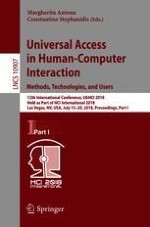2018 | Buch
Universal Access in Human-Computer Interaction. Methods, Technologies, and Users
12th International Conference, UAHCI 2018, Held as Part of HCI International 2018, Las Vegas, NV, USA, July 15-20, 2018, Proceedings, Part I
herausgegeben von: Prof. Margherita Antona, Prof. Constantine Stephanidis
Verlag: Springer International Publishing
Buchreihe : Lecture Notes in Computer Science
